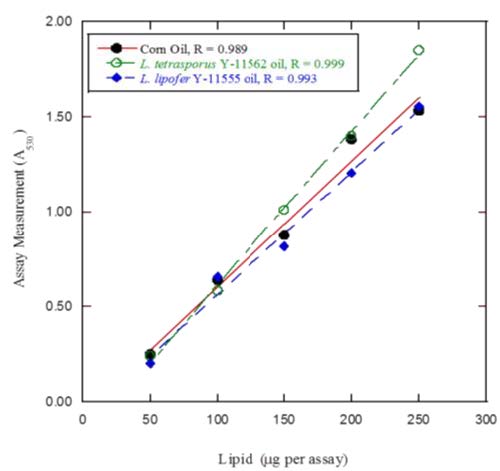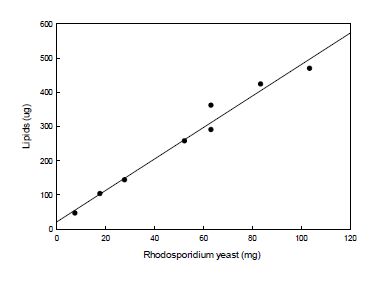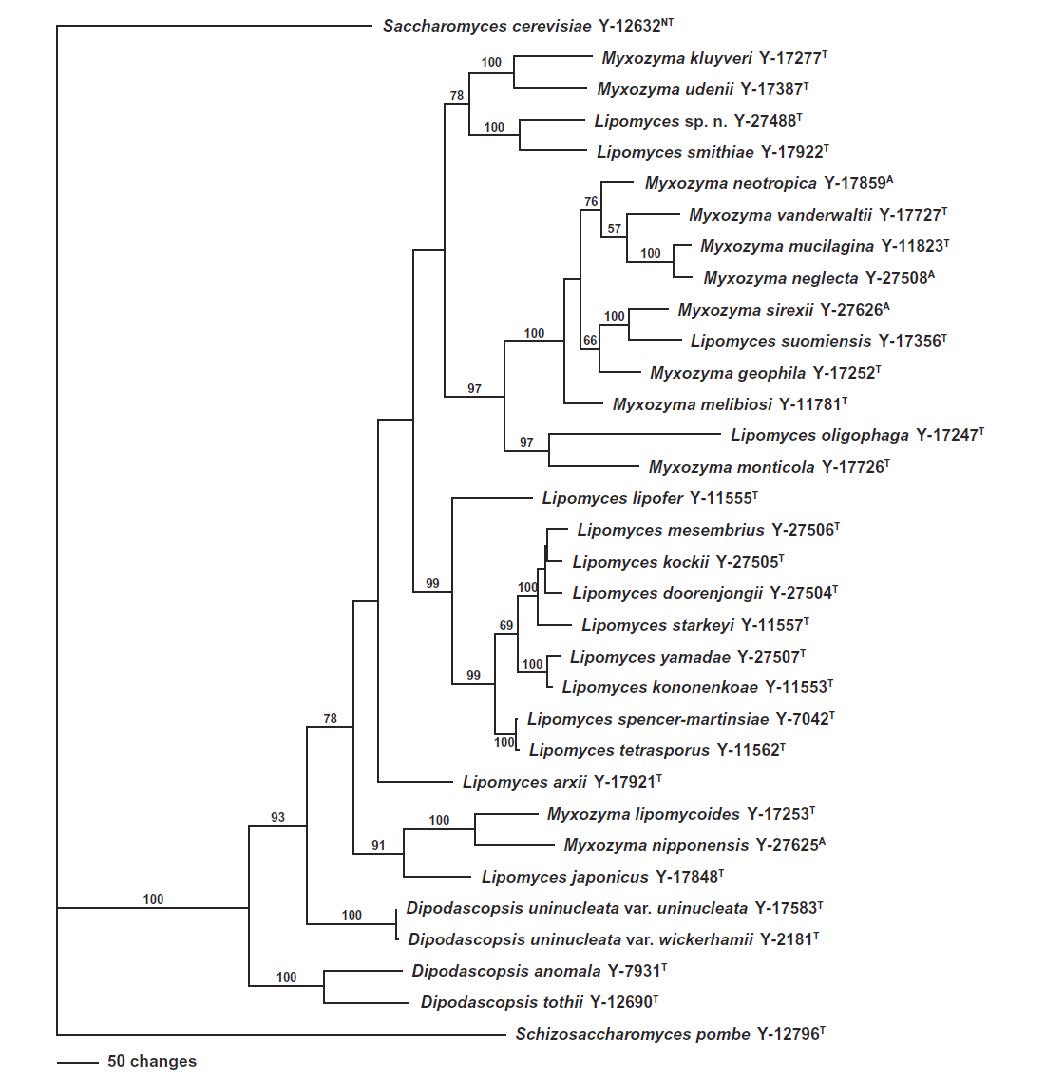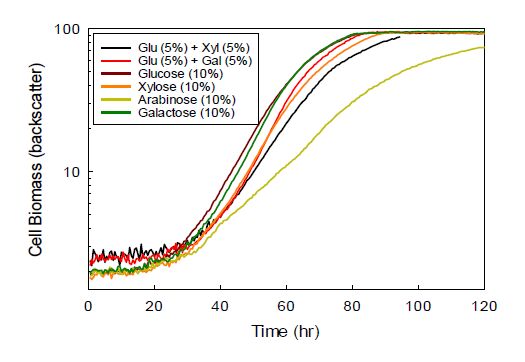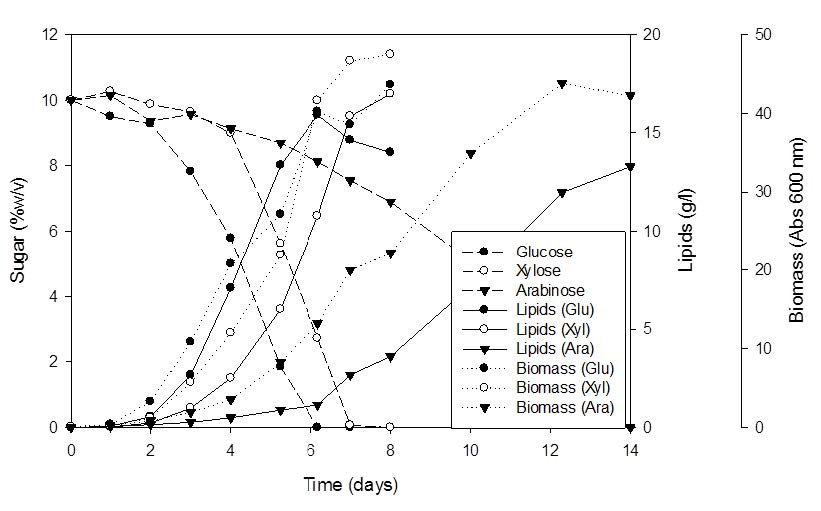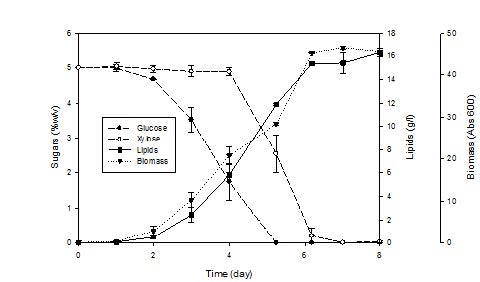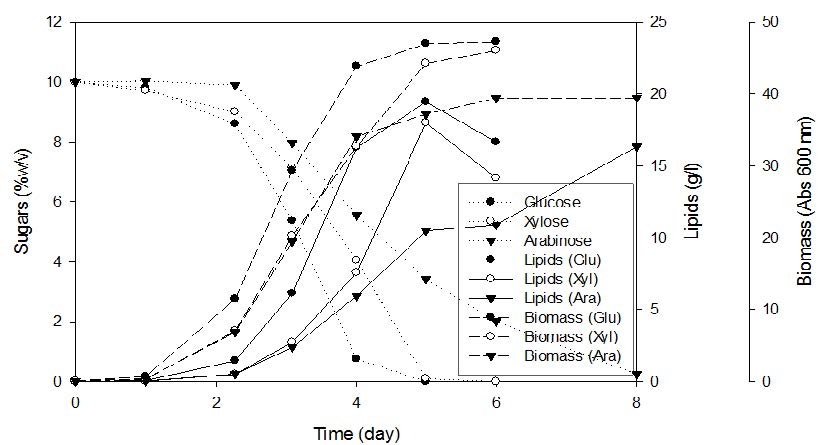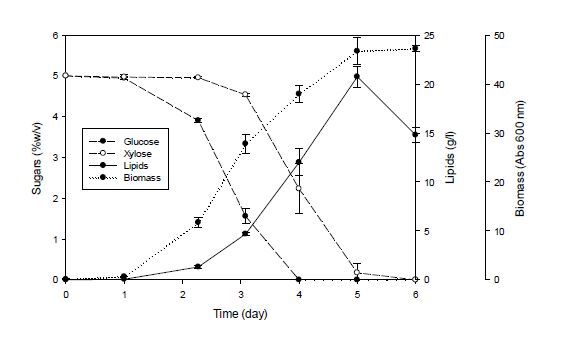Oleaginous yeasts are of interest for production of single cell oils from sugars. Eighteen members of the Lipomyces and Myxozyma clade were screened for lipid production when cultured on 10%w/v glucose. The highest ranking yeasts included L. tetrasporus (21 g/L), L. spencer-martinsiae (19.6 g/L), and L. lipofer (16.7 g/L). By contrast, Rhodosporidium toruloides, which was included as a positive control, produced 16.7 g/L. The L. tetrasporus and L. lipofer were further characterized for growth and lipid production on sugars present in biomass hydrolysates. These included L-arabinose, xylose, and an equal glucose and xylose mixture. L. tetrasporus had lipid titers of 16.3–20.8 g/L and L. lipofer 12.5–17.0 g/L. When both strains were grown on an equal mixture of glucose and xylose, xylose was consumed immediately following glucose. Lipid contents for the yeasts consisted primarily of C18:1 and C16:0, which makes them a promising source of lipids for fuel applications.
1.
Introduction
In the recent era, global warming has emerged as one of the significant environmental problems which adversely affect the sustainable economic performance of a country and a threat to environmental quality and human well-being [1,2,3,4,5,6,7,8,9]. The environmentalists believe that greenhouse gases (GHGs) are mainly responsible for the increase in global temperature that affects natural and human ecosystems [10,11,12,13,14,15]. Carbon dioxide (CO2) emissions have the leading contributor to climate change and global warming, which has quadrupled after 1960 (The United States Environmental Protection Agency, 2020). Moreover, global energy consumption and total products account for 81% of global CO2 emissions [7,8,9,16,17,18,19]. The high-income countries do not exempt from these ecological concerns. High-income countries cannot be immune to these environmental problems because their swift growth in the past few decades has caused serious concerns regarding the ecosystem. For instance, high-income countries are rapidly growing countries and are accompanied by increased gross domestic product, energy consumption, population, resources, thereby increasing ecological footprint and CO2 emissions [7,20,21]. It depicts that urbanization, natural resources, exports, and services intensity play a significant role in determining the environmental degradation in a country. The increasing concern of countries regarding climate change and global warming have pushed them to formulate ecological policies to mitigate ecological footprint (EFP) and carbon footprint (CFP).
Large differences in average emissions between countries and much larger differences in emissions within each country cause global disparity in per capita emissions. In Europe, average CO2 emissions per person and year are currently at 10 tones. The average person in North America emits roughly 20 tones. In China, this falls to 8 tones, 2.6 tones in Southeast Asia, and 1.6 tones in Sub-Saharan Africa. Since the Industrial Revolution, North America and Europe have accounted for almost half of all emissions. China supplied around 11% of the total historical total, whereas Sub-Saharan Africa contributed only 4%. Because of their higher-than-average increases in income and wealth, as well as the carbon impact of their investments, emissions from the wealthiest 1% of people have increased faster than any other group since 1990*.
* How large are inequalities in global carbon emissions—and what to do about it? | Human Development Reports (undp.org)
The concept of ecological footprint is primarily developed by [22]. It measures the area of land which is required to produce crop, forest, sea and river fishes, grazing activities, built-up land for unban activities and to assimilate carbon emissions and waste as generated by a region, a nation or society each year. This is a material resource consumption accounting tools by comparing ecological footprint with biocapacity while the unit measure is global hectare per capita [23,24,25,26]. Ecological footprint is the sum of footprints of cropland, forest, fishery, grazing, carbon, and built-up land. The major contributor to ecological footprint is the carbon footprint because human activities put huge pressure on global in form of carbon emissions [25]. According to the Global Footprint Network, ecological footprint represents demand for material resources, whereas bio capacity represents supply. The global hectare is the ecological and bio capacity measurement unit, with one hectare equaling about 2.47 acres. The total value of the crop, forestry, fishing, grazing, built-up, and carbon footprints is the ecological footprint. Crop footprint, for example, is the amount of land allocated to crops and crop-related goods for human consumption, animals, textiles, and other materials. Grazing footprint refers to the amount of land dedicated to grazing operations for animal products. In contrast, forest footprint refers to the amount of land devoted to the production of wood and paper. Fishery and fishery-related footprints are represented by land allocated to infrastructure, transportation, housing, industrial structures, and hydropower reservoirs, while built-up footprints are represented by land allocated to urban activities such as infrastructure, transportation, housing, and industrial structures.
Environmentalists need to identify various global, environmental, and economic policies to mitigate ecological degradation and safeguard the environment to address these issues. Several existing studies have identified the role of various global and economic factors that help to mitigate environmental degradation and protecting the environment. For instance, industrialization [27,28,29,30]; energy consumption [29,31,32]; Globalization [33,34,35,36,37,38]; natural resources [39,40,41], still existing studies fail to demonstrate sufficient harmony regarding above-mentioned factors. Moreover, the relationship between natural resources and environmental quality has been comparatively less discussed. In recent studies, few researchers have investigated the role of natural resources as the potential factor to determine the environmental quality [36,42,43,44,45,46]. They have identified that abundance of natural resources can shape the ecosystem and mitigate environmental degradation. However, previous studies less focused on the role of natural resources in deriving the EFP and CFP; that's why there is a strong need to explore how natural resources affect EFP and CFP. Additionally, the empirical results of our study will be a significant contribution to fill the gap in the existing literature. In fact, this research will be very helpful for high income countries and policymakers to realize how to control environmental degradation focusing on certain factors. This study and its recommendations will help policymakers to develop better policies for environmental sustainability.
Studies [47,48,49,50,51] investigated the nexus between natural resources and environmental quality while using various control factors. For example, de Souza et al. [47] examined the influence of renewable and non-renewable energy consumption on carbon emissions, which is used as a measure of environmental quality, as well as economic growth as a control variable. The relationship between non-renewable energy consumption and carbon emissions is positive, while the relationship between renewable energy consumption and carbon emissions is negative. Ibrahiem and Hanafy [48] obtained alternative energy resources improves environmental quality. There is existed a cointegration among variables. Rehman and Rashid [49] used the panel unit root test to evaluate the influence of energy consumption on environmental degradation and discovered a positive relationship between energy consumption and environmental degradation. The research backs up the Pollution Haven Hypothesis. Sarkodie and Adams [50] obtained the significance role of disaggregated and aggregated energy with other factors while using time series data and also tested environmental Kuznets hypothesis. However, they obatined mixed conclusions while using different indicators for environmental quality.
The purpose of the present study is, for the first in the existing literature, to investigate the considerable role of urbanization, natural resources, ecological efficiency, and energy intensity in determining the ECF and CFP for high-income countries; as these are expected to act as potential predictors of ECP and CFP and helps policy-makers to know how environmental degradation can be reduced by controlling those factors. The existing studies, such as, Salman et al. [52] analyzed sustainable production and consumption by utilizing ecological footprint and human development index (HDI) for Belt and Road initiative countries. (This is the novelty to take into account factors affecting the high income countries ecological footprint and carbon footprint.
The rest of the study is organized as follows. Section 2 reviews previous studies; section 3 explains material and method employed in this study; section 4 elaborates results and discussion, while section 5 concludes the whole study.
2.
Data and model specification
This study analyzes various drivers of total ecological and carbon footprints for high-income countries. The selected countries Australia, Austria, Bahrain, Belgium, Canada, Cyprus, Czech Republic, Denmark, Estonia, Finland, France, Germany, Greece, Hungary, Japan, Ireland, Israel, New Zealand, Netherland, Norway, Portugal, Poland, Qatar, Spain, Singapore, Sweden, Saudi Arabia, Slovenia, Slovakia, Switzerland, Trinidad, United Arab Emirates, United Kingdom, and the United States.
In this study, our main objective is to find the factors affecting ecological footprint and carbon footprint by utilizing STIRPAT model. Based on the well-known population, affluence, and technology-STIRPAT-theory framework [53,54,55], the present study employs the following models:
where EF shows ecological footprint; CF is carbon footprint; GDP is GDP per capita; GDP2 is GDP square per capita; URB denotes urbanization rate; POP implies total population; FF is fossil fuels; NR indicates natural resources, while EF is ecological efficiency, i = 1, …, 34 stands for the country; and time period t = 2003, …, 2015. The data is obtained from the World Bank Development Indicators; and Global Footprint Network. Table 1 demonstrates the summary statistics of all variables.
The summary statistics is reported in Table 1 which provides minimum, maximum, values of all variables along with mean and standard deviations. The results of descriptive statistics demonstrate positive values of all the variables. The calculated variations seem sufficient for further empirical analysis.
2.1. Econometric methodology
Following York et al. (2004) model named Stochastic Impact by Regression on Population, affluence, and Technology (STIRPAT) which is the extension of the IPAT model developed by Ehrlich and Holdren (1971). The IPAT model consists of four variables, namely Influence(I), Population(P), Affluence(A), and Technology(T), is expressed as follows:
Following Zhou and Li (2020), the impact of population, affluence, and technology on influence variables is expressed as follows:
After augmenting stochastic variable and logarithm transformation, the Eq (4) is expressed as follows:
The dependent variables in this study are total ecological and carbon footprints. The ecological footprint which was primarily developed by [22] for human activities' impact on the earth. It is a comprehensive indicator that depicts the direct and indirect effects of human activities on environmental degradation [56]. As a result, the following models were used to study the determinants of total ecological and carbon footprints:
The Global Footprint Network provided the ecological and carbon footprint statistics. It is a non-profit international organization that calculates the ecological footprint by subtracting the annual consumption of agriculture, forest, grazing land, fishing grounds, carbon footprint, and built-up land activities from the hectares of land produced. The overall ecological footprint worldwide hectares per year is multiplied by the yield and equivalency factors. To improve the accuracy of ecological footprint aggregation, double counting is preventing at all stages. The raw input data for the computation of a country's ecological footprint comes from a variety of sources, including the Food and Agriculture Organization, the International Energy Agency, the United Nations Commodity Trade Statistics Database, the World Development Indicator Database, the Conference Board, the Center for Sustainability and the Global Environment, and other databases [57]. Besides, the World Bank classification uses for high-income countries selection†.
† The World Bank classifies the high-income countries with a per capita national income of the $US 12,055 or more.
3.
Empirical results and discussion
Table 2 shows the results of the panel regression analysis, with model 1 representing the factors of overall ecological footprint. Economic growth and its square term have statistical significance, indicating that ecological footprint grows with initial economic expansion and decreases with further economic growth. This validates the Kuznets theory for the environment, Zhang et al. [58] found similar results for developed countries. Destek and Sarkodie [27] come at the same conclusion for 11 newly industrialized countries. It is acceptable to conclude that high-income countries support green economic growth by employing new, reliable, green, and clean technology. The findings support the positive and statistically significant influence of population, urbanization, and fossil fuels on total ecological footprint, and negative impact of ecological efficiency. The positive effect of the population reveals that increasing the population enhances the ecological footprint of high-income countries, which is consistent with [59], but not with [60] findings in a country-specific instance. Time series analysis and discrepancies in additional control variables could be the culprits. The positive impact of urbanization shows that increasing urbanization increases the ecological footprint of high-income countries, which is similar to [61] in a country specific case; similar result obtain [62], while for emerging economies while Zhang et al. [58] results do not match the study findings. This positive link can be explained by the fact that increased urbanization increases demand for residential, industrial, and transportation services, which in turn increases material resource consumption, i.e., ecological footprints.
The positive impact of fossil fuels demonstrates that increasing fossil fuel use has a negative impact on the environment. Solarin and Al-Mulali [63] found similar results for developed and developing countries. This result is fair since expanding diverse economic activities to boost economic growth increases fossil fuel consumption, emissions, and environmental quality via increasing ecological footprint. The negative link between footprint and ecological efficiency demonstrates that increasing ecological efficiency in high-income countries reduces footprint.
In Table 3, the findings of model 2 of carbon footprint validate the U-shape association between carbon footprint and economic growth. Increases in initial economic growth lower carbon footprint, while further increases in economic growth raise carbon footprint after a certain point. The population impact on carbon footprint is positive and statistically significant, with a 0.05% increase in carbon footprint for every 1% rise in population. This is logical since residents of high-income countries need more material goods and services to maintain a higher quality of life, which results in increased carbon emissions. Furthermore, the gas consumption is statistically significant, with a negative sign to the estimated coefficient. This means that for every 1% increase in gas, the carbon footprint is reduced by 0.03%. The negative and statistically significant estimated coefficient of ecological efficiency suggests that increased ecological efficiency reduces the carbon footprint of high-income countries.
The results of diagnostic tests are presented in Table 4. The findings indicate absence of heteroskedasticity, and serial correlation in econometric model. Furthermore, the results of the JB normality test show that the errors are normally distributed.
4.
Conclusion and policy implications
The current study tends to be relevant in both literature and practice, as it will close existing gaps in the literature regarding empirical findings, EKC hypothesis, and various determinants of environmental degradation. This study enriches the literature on EKC and environmental quality by providing empirical evidence from the high income countries.
The aim of present study is to investigate the various determinants of ecological footprint and carbon footprint by collecting data from 34 high-income countries over the period 2003–2015. According to the econometric results, it is concluded that an inverted U-shaped EKC hypothesis is supported by the panel of high-income countries in case of total ecological and carbon footprint. It is important to note that ecological efficiency led to reduce the sample countries' footprints. The primary influencing elements for a responsible growth in total ecological footprint are population, urbanization, and fossil fuels. It may be concluded from the findings of carbon footprint that population, coal and oil energy all raise carbon footprint. Thus, reducing population, fossil fuel, coal, and oil energy consumption, promoting pro-environmental urban planning and moderating economic growth with less reliance on emissions intensity production could all be viable policy options for high-income countries to reduce their footprints.
Practically, this research will be useful for high income countries and policy-makers to realize how to control environmental degradation by controlling and focusing on certain factors. our study is helpful for policy-makers to develop ways of green energy through R & D that is effective to lower EFP and CFP. This research and its recommendations will help policy-makers in developing efficient and effective policies regarding environmental awareness, economic development, human capital, and environmental sustainability. This study and its recommendations will help policymakers to develop better policies for environmental sustainability.
Conflict of interest
The authors declare no conflict of interest.
Funding
This paper was supported by the Second Tibetan Plateau Scientific Expedition and Re359 search Program (STEP), (Grant No. 2019QZKK0902) and National Natural Science Foundation of 360 China (Grant No. 42077275). It was also supported by Youth Innovation Promotion Association of 361 the Chinese Academy of Sciences (2018405).









 DownLoad:
DownLoad:


